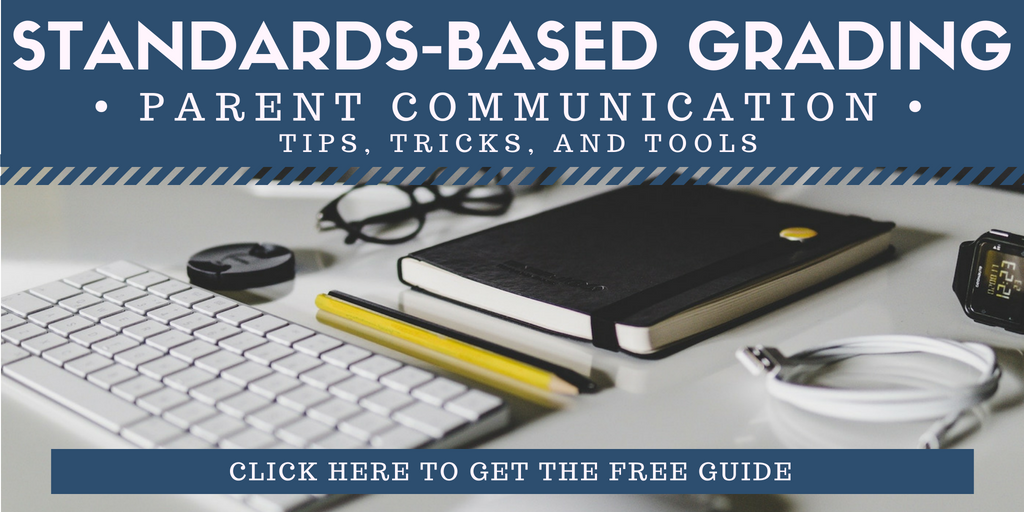Have you considered the “gray area” during the transition from a traditional grade book to Standards-Based Grading?
It can take multiple years for an effective shift to Standards-Based Grading for grade books and feedback provided in the classroom. As districts navigate the transition, there is a lot to think out, plan out, and put into practice. So, how do teachers manage in the meantime?
Just like the stages of grief, every large initiative implementation (whether it be district or teacher driven) has stages. Let’s talk about how to handle the stages of moving from a grade book / percentage mindset, to a fully implemented Standards-Based Grading Grade book & philosophical shift. Oh! And lets not forget the valuable tools we provided to make it even easier!
Stage One: Research & Facilitated Discussion
This one is easy, because this is where it all begins. Whomever is leading the charge toward a Standards-Based Grading transition must begin with understanding the research behind this mindset. Do not choose to go into a new initiative implementation without this step!
The leader needs to begin communicating the “Why” behind this shift.
Unsure where to begin? Read the basics within our 9-Part Series on Standards-Based Grading.
Whomever is leading the charge toward a Standards-Based Grading transition must begin with understanding the research behind this mindset. Share on X [scroll down to keep reading]
Stage Two: The Small “Grade Book Fixes“
Start with baby steps! “A Repair Kit for Grading: Fifteen Fixes for Broken Grades,” written by Ken O’ Connor, is full of small “fixes” to begin altering a traditional classroom into a Standards-Based philosophical shift.
Teachers can still utilize the 100 point scale, but begin to reflect on small changes which are positive shifts for student success.
For example, Fix 3 evaluates the effects of a “Zero” in the grade book. How can this affect your students both mathematically and mentally?
Stage Three: Link your Grade Book to Your Standards
Regardless of what you choose to put in the grade book, link it to a learning standard / learning target. This allows you to focus on specific elements you are evaluating your students’ understanding on, while also giving the student detailed information and feedback on how they are performing on specific elements.
This requires a true moment of reflection on what you want to evaluate and place within the grade book. To evaluate more than one standard or learning target, be sure to enter the assignment in the grade book multiple times to evaluate each small piece.
Example: A 6th Grade Math Teacher is assessing the following Common Core Standards on one Summative Assessment:
- CCSS 6.NS.B.2: Fluently divide multi-digit numbers using the standard algorithm.
- CCSS 6.NS.B.3: Fluently add, subtract, multiply, and divide multi-digit decimals using the standard algorithm for each operation.
In the grade book, you would provide a separate score for each standard. Therefore, this summative assessment would have two scores in the grade book – one for CCSS 6.NS.B.2 and one for CCSS 6.NS.B.3. Providing targeted feedback to the student.
Stage Four: The Grade Shift
Begin adapting your grade book! Using a percentage-based grade book is not ideal when educators begin transitioning to Standards-Based Grading. Regardless, this shift does not happen overnight. So, how do we manage this when we are mentally ready for the SBG shift, but feel confided using a percentage-based scoring system? Shift your scale!
Most Standards-Based Grading scales utilize a tiered system. Each numeric value is connected to a vocabulary term describing the student’s level of understanding. Therefore, make your grade book mirror this essential pillar. Choose to make everything out of 4 points in your percentage-based grade book – and when I say everything, I mean everything.
- 2 = Needs Development in Understanding
- 3 = Progressing Understanding
- 3.5 = STRONG Understanding
- 4 = Exceeding Understanding
DOWNLOAD THE LEVELS OF UNDERSTANDING POSTER FOR FREE!!
This idea allows you to provide effective feedback to your students, focused around what the student understands about the content.
Stage Five: The Brainstorming
Brainstorm an implementation plan with staff and stakeholders! This allows others to feel involved in the transition and begin to take ownership in the process. Remember, a large shift can not occur overnight. It’s a marathon, not a sprint.
Stage Six: The Pilot Group & Reflection
Test out a voluntary pilot group with a Standards-Based grade book. Focus on communication with this group, to hash out challenges they come across. Provide support, or seek out support from your PD providers, to make sure this pilot group has somewhere to turn when they hit roadblocks. One of the biggest mistakes we see is a lack of support, which typically leads to teachers hitting a snag, having nowhere to turn to, and dropping the initiative. There’s more on that in this District Initiative Implementation Guide.
Stage Seven: The Shift
Go for it!
While the “gray area” between any shift can be challenging, these simple steps can allow educators to take manageable and sensible steps toward a more effective transition from the ancient traditional grade book toward Standards-Based Grading!


